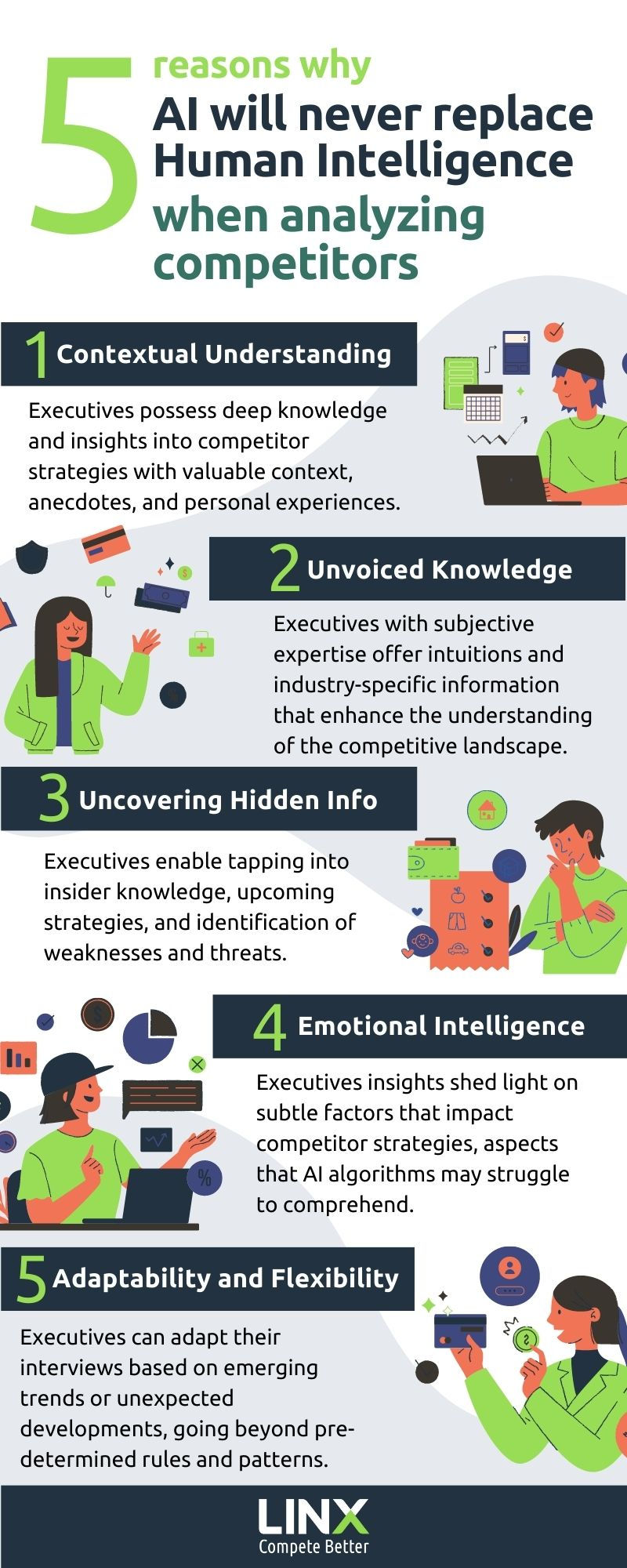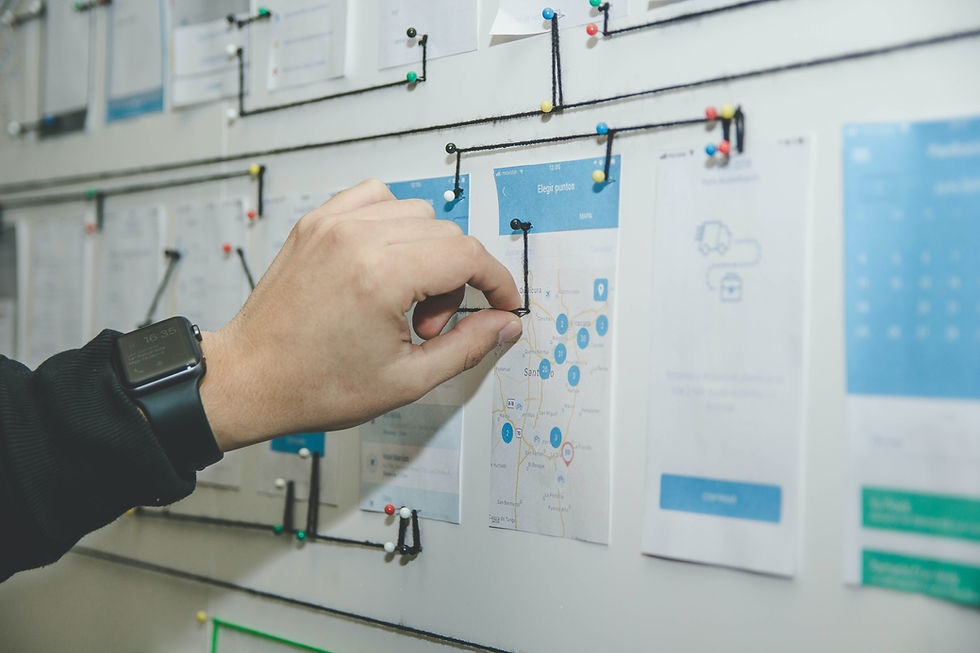Well, It Is Artificial After All: AI Cannot Replace Human Intelligence When Analyzing Competitors
- Yigal Cohen
- Jun 16, 2023
- 4 min read
Updated: Apr 17, 2024

In today's rapidly evolving business landscape, Competitive Intelligence (CI) plays an instrumental role in helping businesses gain the upper hand over their competition. As Artificial Intelligence (AI) technologies continue to advance, they have started to significantly shape the field of CI. AI offers impressive CI capabilities, such as automating data collection, simplifying processes, and improving forecasting accuracy. However, despite these groundbreaking advancements, human intelligence remains irreplaceable in CI, mainly through interviews with executives.
This article will delve into the transformative role AI plays in CI and emphasize why human intelligence will persist as an essential component in the pursuit of competitive advantage.
Part 1: How AI is Changing Competitive Intelligence
Artificial intelligence (AI) is in the process of revolutionizing the field of competitive intelligence (CI), ushering in significant changes in how businesses gather and analyze data

to gain a competitive edge. As we have seen in other discussions, specific tasks are better handled by AI, while others require a human analyst's touch. This is evident in the benefits and opportunities AI integration into CI practices offers businesses across various industries:
Automated Data Collection and Analysis: In tasks such as bulk scanning and filtering for known issues, or providing early warning for known risks and opportunities, AI shines. It automates data collection, saving time and effort. It efficiently gathers and analyzes data from diverse sources, providing valuable insights for informed decision-making.
Enhanced Market and Customer Insights: AI analyzes market data, identifying patterns and trends for deeper insights. Broad industry-wide indicators and dashboards are tasks where AI can be a preferred option. It acts as a surveillance system, keeping businesses updated on industry developments and enabling them to adapt strategies for a competitive edge.
Improved Forecasting and Predictive Modeling: AI's advanced analytics improves demand forecasting accuracy. However, its effectiveness in the long-range and strategic analysis may be limited compared to a human analyst due to the complexity and novelty of certain scenarios.
Streamlined Competitive Analysis: AI tracks and monitors competitors' activities, enhancing competitive analysis. It provides insights into competitor strategies, pricing, and promotions, enabling businesses to outperform and differentiate themselves.
Simplified Internal Processes: AI automates tasks like customer service and inventory management, optimizing efficiency. It frees up resources and improves operational effectiveness, empowering businesses to focus on strategic decision-making.
However, it's crucial to note that speed is an important factor in CI reporting, and who is faster depends on the task. In instances where there are thousands of documents or sources to search and the AI has been trained for the task, an automated tool is best. But in searching for new threats, opportunities, disruptions, or innovation, a human analyst will generally deliver the results faster.
Part 2: Why Human Intelligence will always be irreplaceable by AI
Despite AI's transformative capabilities in competitive intelligence, human intelligence, particularly through interviews with executives, remains indispensable for several reasons.

While automated solutions may deliver more generic reports, a discussion between an executive and either a dedicated intelligence analyst, or even a colleague at an event, both understand the business, the competitive landscape, and the broader market, can provide the most impactful insights.
Here's why human intelligence will always play a crucial role in CI:
Contextual Understanding
Executives possess deep contextual knowledge that complements AI-driven data analysis. Their insights into market dynamics, customer behavior, and competitor strategies provide valuable context, anecdotes, and personal experiences that augment quantitative data.
Example: A Pricing model of a competitor can be dynamic and elaborate. Without a correct context, it can be inaccurate.
Tacit Knowledge
Executives' years of industry experience and expertise provide them with tacit knowledge that cannot be captured solely through AI algorithms. This subjective expertise offers insights, intuitions, and industry-specific information that enhance the overall understanding of the competitive landscape.
Example: When speaking with a customer of your competitor, you can use a "leading questions" technique, presenting facts that you want the other side to react to in a way that you can hear if it is validating or canceling your argument.
Uncovering Hidden Information
In tasks related to the identification of emerging issues, opportunities, and threats, a human analyst will deliver the best results. Interviews with executives enable businesses to tap into insider knowledge, upcoming strategies, and emerging trends that may not be readily available through public sources or captured by AI algorithms.
Example: Features and functionalities of competitor's solutions are often demonstrated as totally legitimate and working fluently, whereas in real life you can hear an executive who has an inside perspective revealing the real, not as perfect as pitched, the story behind it.
Emotional and Social Intelligence
Executives possess emotional and social intelligence, allowing them to interpret complex human interactions and dynamics within their industry. Their insights shed light on subtle factors that impact market dynamics and competitor strategies, aspects that AI algorithms may struggle to comprehend.
Example: AI may identify a pattern of cost reduction across several vendors in the market, however, an executive working for a system integrator can easily explain the reasons behind that, adding interpretation to what is common to these vendors.
Adaptability and Flexibility
Executives can adapt their interviews based on emerging trends or unexpected developments, going beyond pre-determined rules and patterns. This adaptability allows for the real-time gathering of valuable insights, responding to the dynamic nature of the business environment.
Example: When speaking with ex-employees of your competitor, there are two ways to approach: You can just ask an open question and see the direction of their answer, or you can use a more provoking approach by presenting a controversial fact to them, making them jump and make an extra effort to show you how knowledgable they are, and you to get more detailed intelligence.
The Golden Mean

In conclusion, while AI revolutionizes competitive intelligence by automating processes and providing data-driven insights, it is the marriage of AI with human intelligence that truly elevates the field. The synergy between data-driven analysis and the qualitative insights provided by executives through interviews creates a comprehensive and robust competitive intelligence strategy. The need for a balanced approach between AI and human intelligence is paramount, combining the best of both worlds for maximum return on investment. In this era of AI, businesses that harness the power of both AI and human intelligence will be best positioned to navigate the dynamic business landscape and seize opportunities for growth and success.




Comments